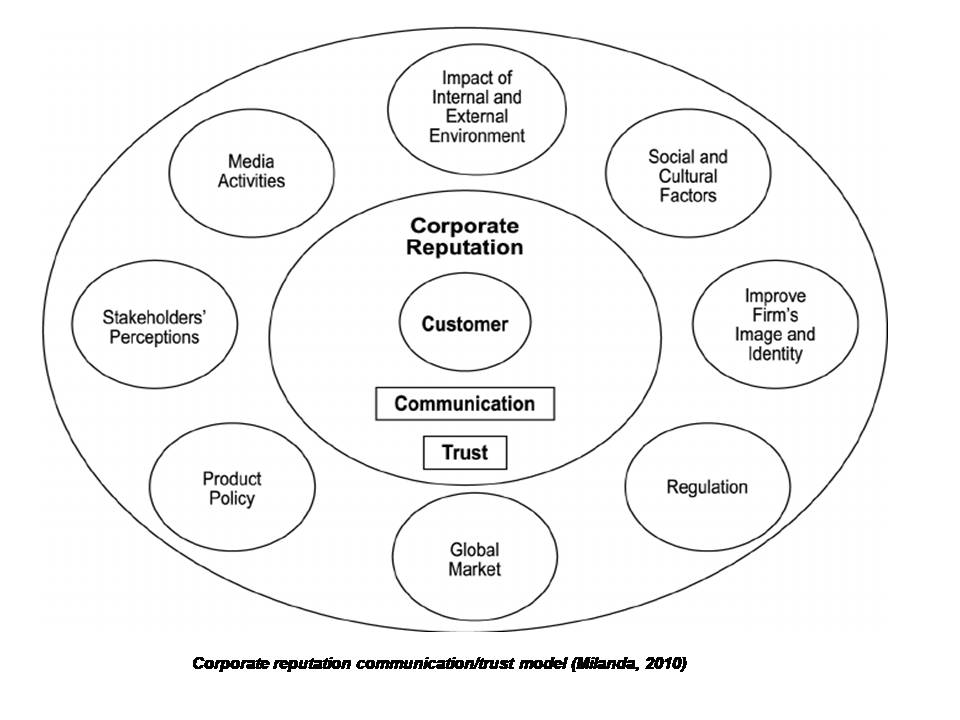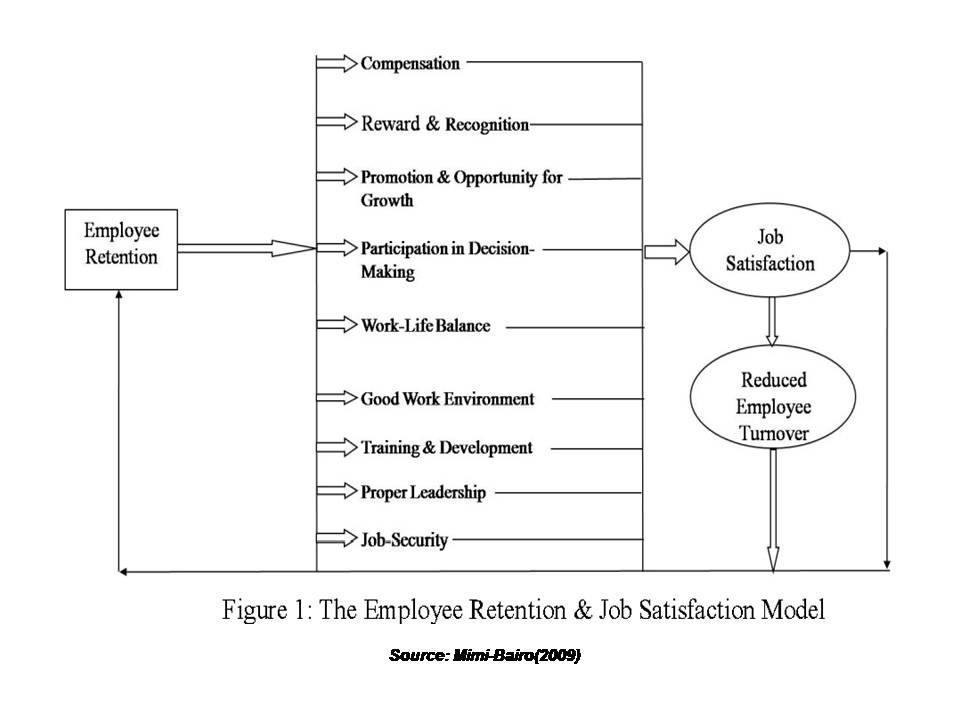
Corporate Reputation as a Key Driver of Employee Retention
The extent of dimensions of reputational challenge in the global business arena is not just a consequence of the severity, acute speed, and drastic economic quagmire, but also of incessant changes in the reputation environment. These changes include the growing importance of social and participatory media that shifted narrative power to the public, the rapid significance of civil societies and other critical community of interest, and dwindling trust in brand advertising and corporate communications (Nina, 2007). In unison, these are the forces that are engendering deliberate and speedy scrutiny of companies and rendering traditional reputation management tools less potent in dealing with these issues.

For quite a long time, corporate reputation has been subjected to series of scholarly studies in management and allied social science research. Many scholars and professionals posit that reputation of an organization remains its critical point of appeal to different stakeholders, its personality and social esteem, its most important asset, the content of its character, as well as its current realties as a consequence generated from its past actions.
Reputation carries serious implication on different areas of organization life. It is generally held by scholars and professionals that corporate reputation constitutes the nucleus intangible properties that define how organization will fare in competitive market (Adoro & Eguruhin, 2000), the quality of support it gets from its stakeholders during crisis (Domen, 2003), Its foray into new market or industry (Allen-Bach, 2000) and most importantly, the quality of talents it attract and retains over a long period
Scholars have explored different dimensions of corporate reputation and how it affects many key components of organization existence and operation. However, they unanimously agreed that corporate reputation enables organization to attract superior talents that deliver on critical corporate capabilities such as innovation, effective internal processes and innovation (Ozerali, 2004). However, attracting best talent through sound corporate reputation is just an half of the job, retaining this quality workforce through corporate reputation is the most critical side of the exercise.
What is germane to this discourse is that corporate reputation assumes more critical responsibilities across many functions within an organization. The fact that an organization’s corporate reputation yields value in the area of attracting people with top quality skills and abilities does not imply that the same level of corporate reputation will keep them in the organization. If what attract these top talents is the corporate reputation, then, managing and improving this corporate reputation becomes very consequential in keeping them.
Success for every firm, regardless of the industry it plays within, is strongly tied to what Chief Executive Officers and business scholars consider as the most vital asset-Employees. Employees are at the center of improved performance of every organization whether it is service-based, manufacturing, Non-for-profit or for-profit.
Within the context of this discourse, it must be established that corporate reputation is a variable in talents attraction and retention. In developed economies where industrialization, economic and social systems are sophisticated, corporate reputation takes top consideration when professionals are starting and pursuing their career. This accounts for why fortune 500 attract best talents and also record very low employee turnover (Chozz & Tedjob, 2003)
Interestingly, in article titled “A Bad Reputation costs a Company at Least, 10% more Per hire” published in March 2016 edition of Harvard Business Review, It is stated that corporation with lousy corporate reputation do make up for their poor corporate reputation by paying minimum of 10% more in wages pay employees a minimum of 10% more than companies with strong corporate reputation.
Aside from this, most corporations with poor reputation will spend more on advertisements and publicity for pushing their vacancies out. It is realized that most of these companies will have to push more awareness of their vacant positions out vigorously in order to engender interests of talents in their originations. However, even when top talents managed to consider working in organizations with poor reputation, they hardly stay working there beyond three years.
In line with the above narrative, this paper addresses the concept and practice of effective corporate reputation as a veritable means of attracting, and most importantly retaining employees. It advances the idea that building and managing sustainable corporate reputation plays a significant role in achieving employee retention.
CORPORATE REPUTATION: CONCEPTUAL ANALYSIS AND FRAMEWORK
Attending to corporate reputation is becoming more crucial in today’s business world than ever. This is brought to bear as a result of important factors such as: customer’s personal experience with a company’s products and services, higher expectations by multiple stakeholder groups, increased public awareness about corporate actions and issues, word-of-mouth and online communication, increased requirement for transparency, effect of the influence of opinion leaders, growth and pressures of interest groups and critical attention from media have all enabled a situation that locate corporate reputation at the center of what makes organization survive or not in 21st century.
In a March 2013 McKinsey Quarterly survey of business leaders and top executives around the world, 83 and 79 percent of them, respectively, stated that public trust in corporations had deteriorated. Furthermore, since 2006, the annual Edelman Trust Barometer has recorded constant decline in public trust in organizations across different industries. People are skeptical about corporation and cynical about what business leaders say in the media. Even, the shareholders’ trust has been on decline pattern across different markets globally.
Previously, organizations were passive in managing their corporate reputation. The predominant practice and disposition to corporate reputation do surface during crisis (Chozz & Tedjob, 2003). In the time of crisis, organization would create a group or committee that would find solution to the crisis at hand as quickly as possible in order to reduce or eliminate the negative effects of the crisis on the organization.
Therefore, active and deliberate management of corporate reputation on a long term basis was not the practice. This reactive approach to reputation management was found to be inimical to business survival and success in today’s corporate environment. Unlike before, organizations are really vulnerable to their operational environment and their sustainability is volatile as never before (Domen, 2003). These realities impinge on managers and business leaders to place premium on corporate reputation management. Corporations such as Enron went into extinction because of lack of effective reputation management. Organizations must strategically and tactically manage their reputations and not wait for eruption of crisis before taking initiatives about their corporate reputation.
The critical role of corporate reputation in building and sustaining the optimal performance of organization across all fronts cannot be undermined. Performing companies place a vital premium on corporate reputation, hence the huge investments that are lavished on initiatives that are targeted at developing and managing competitive corporate reputation (Adoro & Eguruhin, 2000)

Corporate reputation communication/trust model (Milanda, 2010)
According to Walker (2010: 3) “Corporate reputation can be defined as the collective perception of the organizations past actions and expectations regarding its future actions, in view of its efficiency in relation to the main competitors”. Walker’s definition implies that corporate reputation is located within the history of actions and the futuristic pursuits of an organization which is adjudged on the basis of comparison between an organization and its competitors within the same industry.
In the business world, corporate reputation is noted as a vital element of an organization’s provenance in addition and considered crucial in organization financial performance and corporate practice in innovation. Pauland (2015:26) suggests that reputation is a “collective representation of diverse stakeholders’ perception of an organization behavior and culture built up over time”.
Corporate reputation has also been linked to the corporate identity, business performance and the way people respond to a company’s behavior. Brown (2006) defines corporate reputation as the set of corporate associations that individuals and bodies outside attribute to the organization.
Authors and scholars such as Waker (2010) and Chozz & Tedjob (2003) have explored diverse work on corporate reputation to synthesize a holistic body of knowledge and delivered on comprehensive academic standing on what corporate reputation is all about.
Walker (2010), after accumulating myriad of thoughts and ideas derived from his systematic review of body of literature on corporate reputation, related that most definitions on corporate reputation was rendered by Fombrun (1996, p. 72), where he positioned it as follows “corporate reputation is a perceptual representation of a company’s past actions and future prospects that describes the firm’s overall appeal to all of its key constituents when compared with other leading rivals”.
Within the context of asset nature of the reputation which has been advanced by most scholars and practitioners, it is observed that reputation, as critical it is to organization ‘survival and competitiveness, it can also manifest as a liability. Walker (2010) suggests that corporate reputation can be positive, negative or neutral. In his view, corporate reputation is constant with the comparison especially within competitive setting which dominate all industries. This indicates that corporate reputation is set on the practice of certain level of parameters that are set up as benchmark generated from scores made by some firms within every industry.
According to (Ozerali, 2004), Corporate reputation affects the corporate behavior, strategic direction of an organization and the observable corporate traits in which an organization undertake the process of decision-making and planning manner especially with regard to critical issues that are vital to its survival, growth, and profitability. Significantly, corporate reputation is directly connected to the corporate identity of an organization. Basically, it is viewed as ethos, aspirations, values, and goals that drive a sense of commonness and alignment among the organization’s stakeholders.
For a long time, corporate reputation has long been recognized as a critical success factor in marketing. A good reputation is considered as an important asset that can stimulate the consumers’ expectation regarding the company’s offerings. The reputation of a firm drives the effectiveness of corporate and brand communications. The brand management practice has emphasized that competitive pricing and creative advertising play a significant role in communicating product quality.
The crucial nature of intangible asset such as corporate reputation in particular, has grown rapidly. In this regard, corporate reputation enables firms to break barriers in entering into new market or new industry. It is also noted that strong reputation fosters employee attraction and retention, not to mention how sound corporate reputation delivers on high retention of customer loyalty. All these help organization to become highly competitive and profitable even in volatile economies.
Generally, scholars and practitioners in corporate reputation management agree that the concept is centered on the opinion that different constituencies form and the conscious assessment they derive from interacting with an organization and information they are exposed to about the organization over some time (Walker, 2010). This opinion is established on their conviction about what an organization stands for and their associations with it.
A good reputation really pays. It is an established fact that factors that shape reputation can be strategically managed. The investments deployed in carrying out reputation management initiatives do reap major returns for corporate organization (Ozerali, 2004). When organization fails to manage its reputation, the attendant consequences can be quite expensive and leads to corporate death.
EMPLOYEE RETENTION
Employees are the key resource of an organization and the success or failure of organizations depends largely on the quality of employees domiciled within the organization. Talents are a source of competitive advantage for the corporate organization across every industry. Therefore, gaining and sustaining competitive market advantage is directly linked to quality workforce. However, retaining talented employees is more critical to sustainable organizational performance across all key metrics of corporate sound health.
Employee retention is very crucial to the continuity of internal processes and external alignment for corporate sustainability. The critical consideration here is when employees leave; they do depart with intellectual properties, technical capabilities and certain intangible resources that can be transferred to competitors (Boby, 1999).
According to Madueke and Emeriole(2007:4), “employee retention is the ability to hold on to employees where an organization finds that it is losing valuable staff. It is the ability of an organization to retain its employees in their workforce.”
McKeown (2002) submits that some managers and business leaders see employee retention as “reducing the employee turnover rate to an acceptable level whilst others think retention is about compensation and benefits, moreover, some think of it as a component of culture, that is, how people are treated within the organization.”
Whenever an employee leaves walks, normally other staff members notice. In fact, some member of the workforce may even start considering leaving too. Oguntan (2002: 13) states that “the most distress time for managers is not when businesses perform poorly but when highly talented and skillful employees are leaving the companies.” This justifies why employee retention issues should occupy the top consideration companies list of priorities. It implies that creating and sustaining effective retention strategies to stem down employee turnover should take more attention and proactive measures from managers and business leaders.
According to Wille (1994), the starting point of employee retention strategy is to understand and acknowledge the cost of turnover. In his view, employee retention is not only associated with only the monetary cost of turnover but also involves nonmonetary costs which may have an adverse effect on the reputation standing of any firm.
Due to global economic setbacks across all sectors and industries, retaining employees has become a critical challenge which places many companies at a precipice. That accounts for why some strategic management experts caution companies that are bent on retrenchment as a means to cut cost and increase profits during a recession. Significantly, aside from reputational challenge that this strategy may generate, companies will definitely find it difficult to hold down a talented workforce or even attract better talents in the future.

Source: Mimi-Bairo(2009)
To retain talented and competent employees, companies must understand the series of factors which drive an employee’s decision to leave or to stay. Pilbeam and Corbridge (2010) share the notion that identifying the reasons for employees’ departure is of greater importance in understanding and managing retention issue within the organization.
According to Madueke and Emeriole(2004:5) “Organizational commitment has been considered as one of the most important indicators of turnover and intention to leave. It was found that employees who were more committed to their organizations had a lower intention to leave than those with lower organizational commitment.” However, Taylor (2010) relates there are four categories of factors that lead to employee turnover. These factors are pull factors, push factors, unavoidable turnover, and involuntary turnover.
Push factors are internal challenges that are unfriendly or unhealthy to employee’s job satisfaction. These push factors are considered by employees as inimical to their social, economic or emotional well being. This set of factors could be the management disposition to issues that are of importance to the employees. It could also be as a result of interpersonal friction, perceived favoritism, lack of appreciation, low work morale, fatigue as a result of the routine, low remuneration, leadership apathy and so on. However, most studies point out that emotional and social issues account for greater justification for employee turnover.
Pull factor, on the other hand, are factors that are external to the organization. These factors have nothing or little to do with internal make-up or processes within an organization. Employees leave because they are drawn away by other considerations that they consider more irresistible. Such factors, most times, are stimulated by what employees consider as very tempting and seen as factors that represent their desires and aspirations. According to Taylor (2010), this may include an attractive pay package, better working benefits, better opportunity for career growth, and perception of superior corporate reputation of the companies attracting employees.
Furthermore, unavoidable turnover occurs when employees leave an organization as a result of certain circumstances beyond their control. The factors in this instance may include change of career path, further studies, health challenges, family circumstances, climatic conditions, retirement or death, redundancy and so on.
Finally, involuntary turnover occurs when an employee is terminated from a position. In other words, the employee is relieved of his or her position. This may be as a result of poor job performance, negative attitude or dysfunctional social behavior. At times, an organization might lay off staff if the business operation does not accommodate some employees with skills that are not needed at that point in time. The exit of employees under this type of turnover could also be a byproduct of corporate restructuring during merger and acquisition.
According to Dockel (2003) cited in Nyokabi (2018:23), the six major factors that must be seriously considered and managed by business leaders in order to ensure high employee retention are compensation, job autonomy, training, support from superior, career development and work-life policies. In the area of compensation, especially salaries, he noted that higher salaries are not that critical to employees but in as much the salaries are perceived as fair and reasonable within other important parameters such as training, career development, and work-life policies, employees are prone to stay loyal to such organization.
Doherty (2013) cited a survey conducted on components of corporate retention programs with 1000 firms sampled across different categories and types of organizations in the United States. In the study, about 90% of those business managers and top executives stated that employee retention had assumed critical position as a strategic business issue. Interestingly, 15 elements were identified in the corporate retention programs of most of the companies. These programs are as follows:
- Work-life strategy
- Career planning
- Innovative compensation and benefits packages
- Performance management, aligning employee goals with business goals
- Strategies for increasing employee satisfaction
- Employee needs
- Defined role of corporate culture
- Measures of employee satisfaction
- Effective rewards and recognition
- Use of coaching for career development
- Building new-hire commitment
- Competency-based strategies
- Mentoring programs
- An employee strategy to support growth and loyalty
- Merger and acquisition retention strategy
Researchers have established the fact that employee retention has become one of the most challenging management issues for human resource professionals in recent times. It is noted that the exit of certain employees would create a weak loyalty index in the organization which could generate low morale and further exit for other highly talented and skilled employees (Taylor, 2010)
CORPORATE REPUTATION AND EMPLOYEE RETENTION
Employees are internal stakeholders of an organization. They constitute a vital constituency of a company. Therefore, managing employee retention through corporate reputation building becomes very crucial. The reputation of an organization is reflected first to the employees who normally and consistently experience how organization disposes itself in handling its reputation. As such, employees are part and parcel of immediate and critical audience that organization should focus and befriended in managing its corporate reputation.
According to Alniacik, Alniacik & Erdogmus (2012:6) “employees’ role is critical in the creation and maintenance of corporate reputation. They are the primary interface with customers, suppliers and other key partners, and their actions, both positive and negative, can affect how the company is perceived by others”
What has noted across all subject of studies on corporate reputation and employees’ retention is that generally, people love to work for companies with a strong reputation. This accounts for why the most admired companies attract the best and most competent clients. Strong corporate reputation brings emotional satisfaction to employees since most people display pride in announcing the corporation they work for. It has been noted that strong corporate reputation renders some dosage of job satisfaction to employees among other several factors. The fact that there could be a transfer of goodwill from the corporate brand of a highly reputable company to its employees demonstrates the importance of building and managing strong corporate reputation as a tool to deliver on employee retention.
Organizations that build strong reputation are 10 times more likely to attract the best talents and 20 times able to retain them than organization that is slack with their corporate reputation. This is understandable since highly reputable corporations have certain internal processes and corporate culture that is considered favorable by employees.
Conceptual Framework for Organizational Culture and Employee Retention.

Source: Madueke & Emeriole(2017)
Corporate culture, which forms the critical part of corporate reputation, has been adjudged by researchers and practitioners as very strategic in retaining top performing employees. This is because corporate culture affects the totality of work processes and job satisfaction of employees in a direct manner.
According to Collins and Porras (2000) cited in Madueke & Emeriole (2017:3), “organizational (Corporate) culture is a system of shared meaning held by members that distinguish one organization from other organizations. They believe that these shared meanings are a set of key characteristics and that the organization values and the essence of an organizations culture can be captured in seven primary characteristics- They are innovation and risk-taking, attention to detail, outcome orientation, a People orientation, Team orientation, Aggressiveness, and Stability”
The properties of organizational culture are attitudes, habits, norms and deep-seated values of the organization. Culture captures interwoven components commonly acknowledged as cultural web. A cultural web is made up of symbols, rituals, power structures paradigms, routines, control systems, organizational structure, stories and myths. Managers in organizations should create and sustain innovative cultural climate that stipulates and underlie the way employees will be engaged.
Nyokabi (2018) relates that the more similar an organization was with an employee’s values, the more devoted the employee would be and not bothered about looking for jobs elsewhere. Therefore, the corporate values of the organization should be drawn from human experience, sentiments, aspirations, and disposition. Presently, it is well understood by top business leaders that their corporation should have a human face and heart in every aspect of the organization’s life and existence (Folarin, 2002). Most companies are realizing that they must champion causes that are of importance to their employees in order to further deepen the loyalty of the employees.
There is a strong theoretical underpinning which establishes a positive relationship between corporate reputation and favorable employee behavior. The postulation of social identity theory provides justification and explanation for why higher quality employees are attracted by firms with positive reputations. Basically, social identity theory posits that people do classify themselves into social categories based on the basis of group membership and in practice, these social categories influence individuals ’ self-concepts and by extension, self-esteem. Therefore, the membership of an organization has a direct implication on employees’ self-concept and self-esteem. It, therefore, stands to reason that corporate reputation reflects psychological consideration to employees.
Furthermore, Alniacik, Alniacik & Erdogmus (2012:9), after carrying out an empirical study on how Corporate reputation affects employment intentions, find a link between internal corporate reputation management and willingness of job seekers to work in certain companies. They submitted that “that workplace environment, emotional appeal, product quality, vision & leadership, and social and environmental responsibility have positive correlations with employment intentions. In other words, perceptions of different dimensions of corporate reputation (except financial performance) positively affect employment intentions. The better perceived a firm’s reputation(s), the more likely it is to be targeted by prospective employees”
Nyokabi (2018) stresses that factors that encourage employees to remain loyal to an organization are not really of material products. In her study of employee retention pattern in some selected commercial banks in Kenya, she found out that corporate culture as perceived from reputational behavior of these banks carries larger weight in the retention of employees. She submits that components of corporate reputation that influence retention of staff are “espoused beliefs, values, and policies.” She concludes that hiring employees based on organization values and beliefs is strategic to employee retention. This cultural fit is generally stressed in modern human resource literature and practice.
Leadership and management team should work assiduously towards cultivating strong reputations reputation for their companies and offerings. They must be deliberate and strategic in pushing attractive corporate reputation in deeds and expressions especially as they engage employee market by direct and indirect means. In their communications with employee market, they should demonstrate the organization’s commitment to promoting and sustaining competitive work benefits and strong corporate culture.
Bibliography
Adoro, S & Eguruhin, D (2000): Mapping the Reputational Landscape. Corporate Reputation Review, Vol. 4, pp. 20 – 31.
Allen-Bach, M (2000): Winning the war of the Mind through Reputation spinning. Marketing Communications Journal, Issue 3, Vol 2. Centre for Corporate Strategy Studies, University of Ghana, Legon
Alniacik, E; Alniacik,U & Erdogmus, N (2012): How Do the Dimensions of Corporate Reputation Affect Employment Intentions ? Corporate Reputation Review Volume 15 Number 1
Boby , F (1999) Managing People in Modern Organization. Prolong Publishers. Port Harcourt.
Chozz & Tedjob (2003): Strategic Management: Theory and Practice. Frenz Inc. New Jersey
Domen, J (2003): Building Corporate reputation: Critical challenges in 21st Century’, Journal of Consumer Marketing , 08 (2) , 12 – 20 .
Doherty, W (2013): Modeling Corporate Reputation, Trust- Building and Competitive Advantage. Journal of Corporate Ethics, Vol 4, (2).
Folarin, A (2002): Corporate Social Responsibility as an Internal Strategic Marketing. Journal of Corporate Marketing and Brand Management. Vol 4 (4)
Madueke, C & Emeriole, I (2007): Organizational Culture and Employee Retention of Selected Commercial Banks in Anambra State. Saudi Journal of Business and Management Studies Scholars Middle East Publishers Dubai, United Arab Emirates
McKeown, L.J (2002) ‘Employee what?’ 1-22. [ONLINE] Available at: http://www.briefcasebooks.com/mckeown01.pdf
Mimi-Bairo, U (2009): Strategic Approach to Employee Engagement: Issues and Challenges. Journal of Human Capital Development. Vol 7, No 3
Milanda, I (2010): Corporate Communication: Principles & Practice. Loburn Ltd, Lagos.
Nina, A (2007). Internal Communication or Employee engagement: Which way to in Building Employee Loyalty. Journal of Talent Management. Vol 2, Issue 2
Nyokabi, G (2018): Effect of organizational culture on employee Retention in commercial Banks in Kenya. A research project submitted for the Award of the Degree of MBA, school of business, University of Nairobi, Kenya(2018)
Oguntan, M(2002): Managing Corporate culture: Insights from Insurance Industry in Nigeria. Conference Paper delivered at Annual Conference of Chartered Institute of Insurance, Nigeria. Hotel Le Meridien , Uyo, Nigeria.
Ozerali, J, (2004): Strategic stakeholders Management: A Public Relations Approach. Hochdon Publications, Pretoria.
Pauland, G (2015): Corporate reputation management in Volatile Business Environment. Journal of Communications Management, Vol 10(4), 63-74.
Pilbeam, S. & Corbridge, M(2010). People Resourcing and Talent Planning HRM in Practice. 4th ed. England: Pearson Education Limited.
Taylor, S (2010): Resourcing and Talent Management. London: Chartered Institute of Personnel and Development. 334-336.
Walker, K A (2010): A Systematic Review of the Corporate Reputation Literature: Definition, Measurement, and Theory. Corporate Reputation Review, 12(4) 357-387
Wille, G. (1994). ‘Employee retention: A Positive Force’. Credit Union Management, vol. 17(12), 34.
Author: Medinah Hayatudeen Ibrahim, student at LIGS University
The publication was under the supervision of Marian Stadler.



